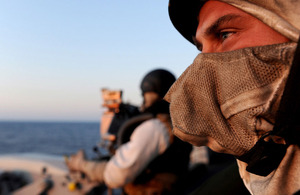IN PICTURES: HMS Liverpool's 100th day of patrols off Libya
Type 42 destroyer HMS Liverpool marks 100 days of patrolling the coast of Libya today, helping enforce the UN Security Council Resolutions designed to protect the country's civilians from Colonel Gaddafi's former regime.

Evening action stations on HMS Liverpool during patrols off the coast of Libya [Picture: Leading Airman (Photographer) Caz Davies, Crown Copyright/MOD 2011]
In that time the men and women serving on her have moved to action stations approximately 30 times as they prepared for gunfire and rocket attacks. They have been engaged directly by pro-Gaddafi forces seven times and fired themselves on 10 occasions.
On nearly 60 of those 100 days she has needed to enter Libyan waters to help stop pro-Gaddafi forces using the Mediterranean coast to move supplies back and forth.
She has also played her part in the skies above Libya with her Fighter Controllers having controlled 14 different types of aircraft for more than 280 hours, and guiding allied aircraft across the battlespace by taking control from the RAF’s E-3 Sentry AEW (Airborne Early Warning) and Sentinel AWACS (Airborne Warning and Control System) aircraft when there was a gap in coverage.
To work this hard has required Liverpool’s ship’s company to show stamina and resolve. The sight of personnel calmly donning white anti-flash suits in the middle of the night has become commonplace.

HMS Liverpool's Commanding Officer, Commander Colin Williams [Picture: Leading Airman (Photographer) Caz Davies, Crown Copyright/MOD 2011]
Liverpool’s Commanding Officer, Commander Colin Williams, has had to guide his people through weeks and weeks of combat operations. He said:
The real sense of pride in seeing tangible results ashore as a result of our actions at sea is felt by all on board. When we took over from HMS Cumberland, the besieged city of Misurata was under imminent threat of collapse; since then we have seen the rebels push the pro-Gaddafi forces back, allowing humanitarian shipping access to the port, and a semblance of normality to return to these once troubled streets.
Liverpool’s ship’s company have worked closely alongside our NATO naval and air partners through long and dangerous hours of constant threat in a professional and resolute fashion, and I am intensely proud to have had the opportunity to command them; they have once again proven why the Royal Navy remains a benchmark for others to follow.
HMS Liverpool is only the latest naval unit to have served off Libya. In February the frigate HMS Cumberland twice raced to the port of Benghazi to evacuate civilians fleeing the fighting. She was followed by the destroyer HMS York, and since then the minehunters HMS Brocklesby and Bangor have provided support while Apache missions are flown from the helicopter carrier HMS Ocean.
But Liverpool is unique in facing repeated attack from Gaddafi’s forces. Earlier this month she prepared to fire her Sea Dart missile system during a tense stand-off with pro-Gaddafi forces in Libya. The Type 42 warship was fired at with multiple rockets which fortunately fell harmlessly a few miles short, meaning she did not have to engage.
The battery where the rockets were fired from was later destroyed by allied Apache attack helicopters flying from HMS Ocean. Commander Williams said:
The artillery that fired at us isn’t there any more. We achieved our mission on that occasion.
The team behaved exactly as I wanted, they were calm and professional. I’m intensely proud of them. We have to observe all of the rules governing our remit out here. We are here to stop the regime harming civilians in accordance with the UN security resolutions.